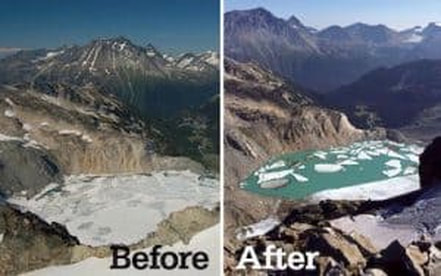Is Climate Change a Myth or Real? An In-depth Analysis to Reveal the Fact Based on Evidence
Grade 7
Presentation
Problem
Introduction
Many people still cling to the myth that climate change is not real, despite overwhelming scientific evidence to the contrary. Some argue that the Earth's climate has always gone through natural warming and cooling cycles, and that the current warming trend is simply part of this natural variation [1]. Others claim that the scientific community is divided on the issue, and that there is not enough evidence to support the claim that human activities are causing climate change.
However, these beliefs are based on misconceptions and misunderstandings about the science of climate change. The overwhelming majority of climate scientists agree that the Earth is warming and that human activities, such as burning fossil fuels and deforestation, are the primary causes of this warming trend. Global temperatures and sea levels are rising, and extreme weather events are becoming more frequent and severe. It is essential that we recognize the reality of climate change and take action to address it before it is too late. Thus, this research aims to clarify the issue of climate change by presenting scientific evidence to raise awareness and combat this crucial problem together.
But why is it important to raise awareness of climate change? Raising awareness encourages self-mobilization, action, and more zeal and support. To manage the effects of climate change, improve adaptive capacity, and lower overall vulnerabilities, awareness-raising plays a critical role in climate change adaptation. Any campaign against climate change aims to bring about long-term behavioral changes that have beneficial effects. The public's engagement is necessary to make these changes. Being conscious increases alertness, which prompts action. After grasping the main points of the matter, the person can assess what modifications to their daily schedule might be ecologically sustainable. That person is aware that certain acts can have unfavorable effects and is taking steps to lessen their carbon footprint. This will assist young people in becoming more climate literate and alter their attitudes and behaviors, and it will help them adapt to the impacts of global warming [2].
We must understand the science behind climate change and the solutions available. We can take many actions to mitigate the effects of climate change, including reducing our carbon footprint, transitioning to renewable energy sources, promoting sustainable agriculture, and protecting our forests [3]. Working together can create a more sustainable future for ourselves and future generations.
This research project targets to:
- Evaluate the current and potential future impacts of climate change on various environmental components, including temperature, precipitation patterns, sea levels, and ecosystems.
- Investigate human-induced factors contributing to climate change, focusing on the emissions of greenhouse gases, deforestation, and other activities affecting the climate system.
- Examine the effects of climate change on biodiversity, species distribution, and ecosystems, considering both terrestrial and aquatic environments.
- Investigate ocean and cryosphere changes, including sea level rise, ocean acidification, ice caps, and melting glaciers.
- Assess the effectiveness of current and proposed adaptation and mitigation strategies, including policy interventions, technological innovations, and community-based initiatives.
The expected impact of this project are the following:
- Contribute insights and knowledge to the scientific community's understanding of the mechanisms and consequences of climate change.
- Increase awareness about the urgency and severity of climate change among the public, fostering a better understanding of individual and collective roles in addressing the issue.
- Encourage collaboration between scientists, policymakers, and community stakeholders to foster interdisciplinary approaches to addressing climate change challenges.
- Propose and advocate for sustainable practices and policies that reduce greenhouse gas emissions and promote ecological sustainability.
- Contribute data, analyses, and findings to the global climate knowledge base, fostering international collaboration in addressing the shared challenge of climate change.
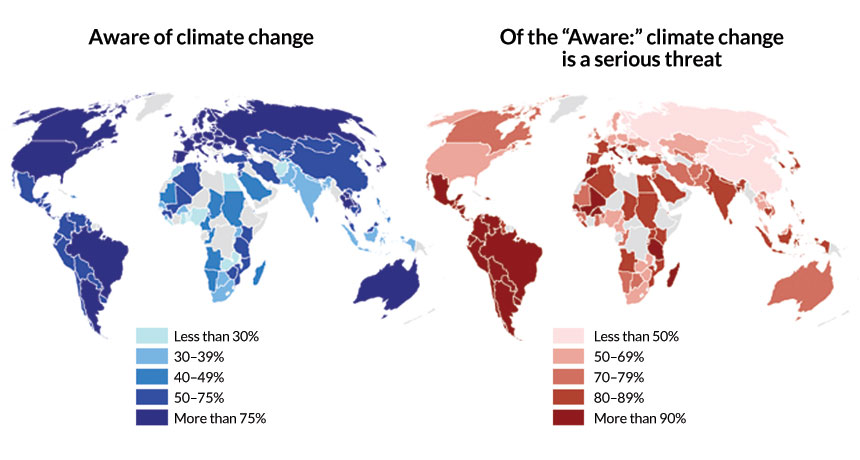
Figure 1: People from more affluent, educated countries typically have greater awareness of climate change. However, those in less affluent, less educated communities typically worry about it more [4].
Method
Climate change is often mired in debate, primarily stemming from a pervasive misunderstanding of the subject matter. This research endeavors to rectify this by establishing a robust comprehension of climate change through extensive research and a thorough literature review. The scientific underpinnings of climate change are elucidated, unveiling both its root causes and tangible effects. Substantive evidence is presented to underscore the critical importance and severity of this global threat.
The United Nations Framework Convention on Climate Change (UNFCCC), initiated three decades ago, has been at the forefront of the battle against climate change. The Conference of the Parties to the Convention (COP) has consistently convened member countries in annual meetings to delineate ambitions, allocate responsibilities, and evaluate climate measures [5]. This research delves into the 21st COP meeting, held in Dubai from November to December 2023, elucidating its significance and critical outcomes in the ongoing effort to combat climate change.
Furthermore, this study explores the multifaceted initiatives undertaken by the Canadian government at the federal, provincial, and municipal levels. These initiatives delineate a comprehensive roadmap towards the Net Zero plan for carbon emissions. Recognizing that achieving the Net Zero target necessitates collective efforts, the research also underscores the responsibilities borne by citizens. Specific initiatives at the individual level are discussed, offering tangible actions to significantly expedite the desired outcome. The research concludes with a resounding call to action, urging individuals of all ages, genders, races, and nationalities to take climate change seriously and unite in the global fight against this crisis.
Research
WHAT IS CLIMATE CHANGE?
Climate change is one of the most pressing issues facing our planet today. Climate change is the long-term temperature and weather changes. These fluctuations may be caused by significant volcanic eruptions or variations in the Sun’s activity. However, human activity has been the primary cause of climate change since the 1800s [6]. Climate change may be specific to a place on Earth or a particular era, leading to less predictable weather patterns [7]. The scientific community has warned us for decades that our actions are causing the Earth’s temperature to rise alarmingly. The impact of this issue is not just limited to the environment but also affects the economy, human health, and social stability [8]. Therefore, we must take action to prevent the worst-case scenarios from happening.
The Causes of Climate Change
Scientists have been studying climate change for years. The leading causes of climate change are primarily due to human activities as such.
Burning fossil fuels:
The decay of buried carbon-based organisms that died millions of years ago produces fossil fuels. They produce carbon-rich deposits, which are mined and burned to generate energy. They are nonrenewable and currently provide around 80% of the world’s energy. They also produce plastic, steel, and many other items. Coal, oil, and gas are the three forms of fossil fuels. When fossil fuels are burned, significant carbon dioxide, a greenhouse gas, is released into the atmosphere. Greenhouse gases trap heat in our atmosphere, causing global warming and climate change. Already, the average global temperature has risen by 1 degree Celsius. Warming exceeding 1.5°C increases the likelihood of sea-level rise, harsh weather, biodiversity loss and species extinction, and food scarcity [9]. In 2019, fossil fuels accounted for 74% of all greenhouse gas emissions in the United States. In the United States, fossil fuels on public lands account for over a quarter of all emissions [10].
Using transportation:
Most cars, trucks, ships, and planes run on fossil fuels. That makes transportation a significant contributor of greenhouse gases, especially carbon dioxide emissions. Road vehicles account for the most prominent part due to the combustion of petroleum-based products, like gasoline, in internal combustion engines. But emissions from ships and planes continue to grow. Transport accounts for nearly one-quarter of global energy-related carbon dioxide emissions. And trends point to a significant increase in energy use for transport over the coming years [11].
Manufacturing goods:
Emissions are produced by manufacturing and industry, primarily due to burning fossil fuels to generate energy for producing items like electronics, plastics, textiles, iron, steel, and cement. The construction sector releases gasses, as do mining and other industrial processes. In manufacturing, coal, oil, or gas are frequently used as machines' fuel; additionally, chemicals derived from fossil fuels are used to make certain materials, such as plastics. Globally, the industrial sector is one of the leading producers of greenhouse gas emissions [11].
Deforestation:
Deforestation is the deliberate clearance of forest areas. Forests have been destroyed throughout history and into the present to create ways for agriculture and animal grazing and obtain wood for fuel, manufacture, and construction [12]. However, carbon dioxide is absorbed and stored by trees. Carbon dioxide and other greenhouse gases are released when trees are removed or disturbed. Around 10% of global warming is caused by forest loss and destruction [13]. Yet, there are solutions to deforestation, such as consuming less, avoiding single-use packaging, eating sustainable food, and choosing recycled or responsibly-produced wood products [14].
Producing food:
The production of food causes carbon dioxide, methane, and other greenhouse gas emissions in several ways, such as deforestation, clearing land for agriculture and grazing, digestion by cattle and sheep, the creation and application of fertilizers and manure for crop growth, and the energy-intensive operation of fishing boats and farm equipment, which typically requires the burning of fossil fuels. Because of this, food production plays a significant role in climate change. Additionally, the distribution and packaging of food contribute to greenhouse gas emissions [11].
Powering buildings:
Over half of all electricity is used by residential and commercial buildings worldwide. They continue to produce many greenhouse gas emissions since they rely on coal, oil, and natural gas for heating and cooling. Energy-related carbon dioxide emissions from buildings have increased recently due to growing air conditioning ownership, growing energy demand for heating and cooling, and increased electrical usage for appliances, lighting, and connected devices [11].
The Effects of Climate Change
There are many effects climate change has on the Earth, some of which include:
Warmer atmosphere:
Greenhouse gases cause this effect of climate change. Carbon dioxide, methane, and nitrous oxide concentrations in the Earth's atmosphere are now higher than ever in the last 800,000 years. These greenhouse gas emissions have exacerbated the greenhouse effect, causing the Earth's surface temperature to rise. Burning fossil fuels has the most significant impact on the climate of any human activity [15]. The atmosphere is important because it contains the oxygen we require to live and shields us from dangerous UV solar radiation [16].
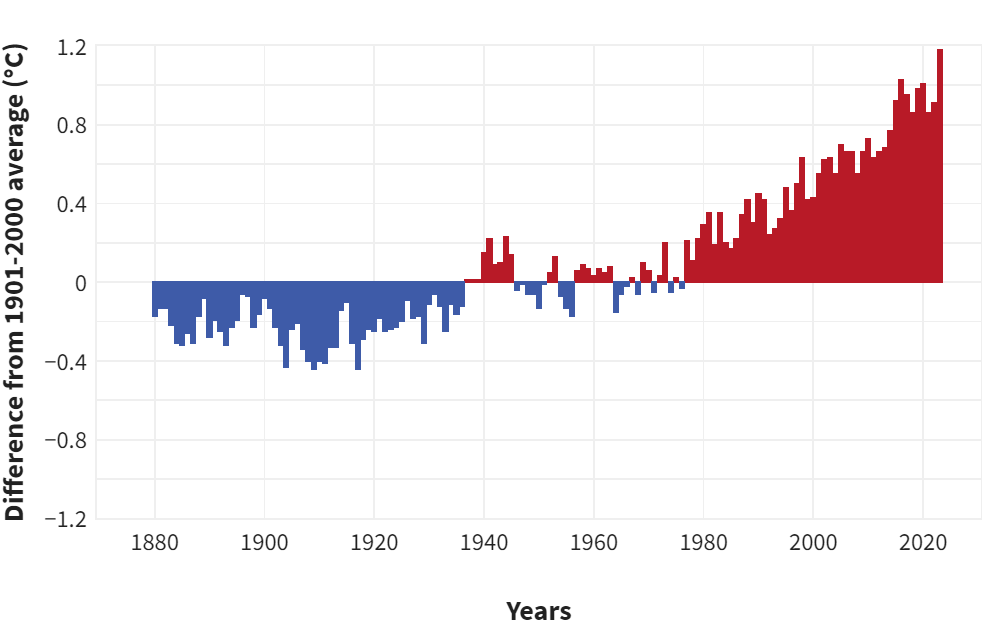
Figure 2: Yearly surface temperature compared to the 20th-century average from 1880–2023. Blue bars indicate cooler-than-average years; red bars show warmer-than-average years. Since 1850, the average annual increase in Earth's temperature has been 0.11° Fahrenheit (0.06° Celsius), or almost 2° F. Since 1982, the pace of warming has increased by more than three times, to 0.36°F (0.20°C) every ten years. By a large margin, 2023 was the warmest year since worldwide records have been kept in 1850. It exceeded the 20th-century average of 57.0°F (13.9°C) by 2.12 °F (1.18 °C). It exceeded the pre-industrial average by 2.43 °F (1.35 °C) (1850-1900) [17].
More intense wildfires:
This drier, hotter climate also fosters more violent wildfire seasons, with fires spreading quicker and burning longer, threatening millions more lives and homes. Between 1984 and 2015, the number of significant wildfires in the western United States more than doubled. Between 1972 and 2018, the annual area scorched by wildfires in California climbed by 500% [18].
Higher sea levels:
Global warming is raising the global mean sea level in two ways. Glaciers and ice sheets are melting and adding water to the ocean. Second, when the water heats, the volume of the sea expands [19].

Figure 3: Predicted sea level rise by the end of this century, showing the range and mid-point of projections for a low greenhouse gas emissions scenario, and a high greenhouse gas emissions scenario [20].
More extensive changes in precipitation patterns:
More evaporation occurs as average temperatures at the Earth's surface rise, increasing overall precipitation. As a result, increased precipitation is projected in many locations as the temperature warms. However, just as precipitation patterns differ worldwide, so do climate change's precipitation effects. Climate change will cause specific areas to see less precipitation by modifying the wind patterns and ocean currents that drive the world's climate system. Furthermore, increased precipitation does not necessarily improve the water available for drinking, irrigation, and industry because higher temperatures cause more evaporation [21].
More acidic ocean:
Although the ocean's ability to absorb carbon dioxide keeps atmospheric levels from rising further, increased amounts of carbon dioxide dissolved in the sea can deleteriously impact some marine life. Carbonic acid is formed when carbon dioxide combines with seawater. The consequent rise in acidity (measured by lower pH values) alters the mineral balance in the water. This makes it more difficult for corals, some forms of plankton, and other organisms to create calcium carbonate, which is the main component of their hard skeletons or shells. As a result, decreasing pH can make it more difficult for these species to flourish. This can cause more prominent changes in the overall structure of ocean and coastal ecosystems, affecting fish populations and the people who rely on them. Damage is already beginning to manifest in some regions [22].
Biodiversity:
The primary cause of biodiversity loss remains people's use of land, particularly for food production. Human activity has already impacted more than 70% of all ice-free land. When land is transformed for agriculture, some animal and plant species may lose their home and become extinct.
However, climate change is becoming a more significant contributor to biodiversity loss. Climate change has impacted marine, terrestrial, and freshwater ecosystems all around the world. It has resulted in the extinction of local species, increased disease rates, and mass mortality of plants and animals, marking the first climate-driven extinctions.
On land, rising temperatures have caused animals and plants to relocate to higher elevations or latitudes, with many migrating to the Earth's poles, with far-reaching repercussions for ecosystems. The likelihood of species extinction rises with each degree of warming [23].
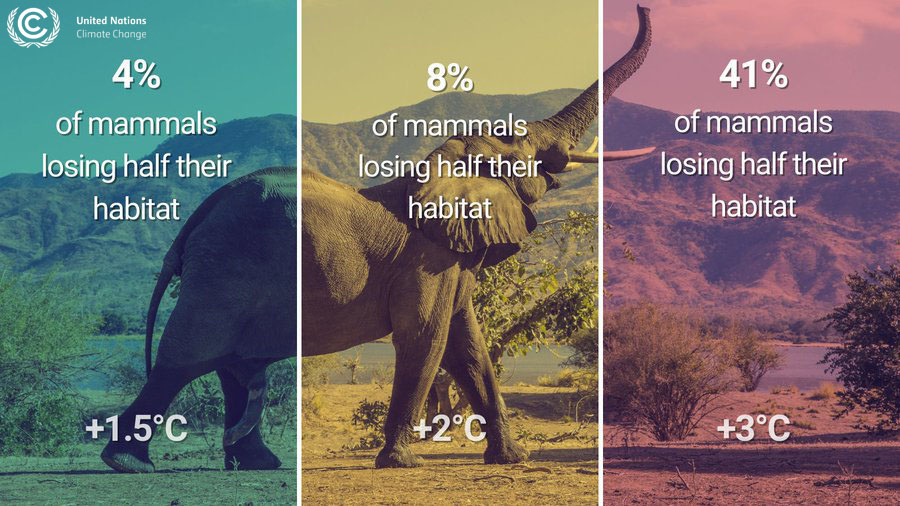
Figure 4: A display of the percentile of mammals that lose their habitat for every degree of warming [23].
Rising ocean temperatures increase the possibility of irreversible loss of marine and coastal ecosystems. Live coral reefs, for example, have been roughly halved over the last 150 years, and further warming threatens to kill practically all remaining reefs.
Climate change has a broad impact on ecosystem health, impacting changes in the distribution of plants, viruses, animals, and even human settlements. This may increase the potential for animals to carry diseases and viruses to infect humans. Reduced ecosystem services, such as the loss of natural food, medicine, and livelihoods, can also have an impact on human health [23].
Ecosystems:
One significant environmental factor affecting ecosystems is the climate. Ecosystems are impacted by climate change in a number of ways. For example, species may be forced to migrate to higher elevations or latitudes where temperatures are more favorable for their existence due to global warming. Similar to this, when sea levels rise, saltwater intrusion into freshwater systems may cause some important species to move or become extinct, eliminating important predators or prey from the current food chain.
In addition to having a direct impact on ecosystems and species, climate change also interacts with other human pressures like development. Even though some stressors have little effect when they occur alone, their combined effects can have a significant impact on the environment. For example, the stress that land expansion puts on vulnerable coastal areas may get worse due to climate change. In addition, if climate change results in an increase in strong rainstorms, recently cleared forest areas might be more susceptible to erosion [24].
Species distribution:
Climate change is influencing species ranges through changes in growth, reproduction, and death, and there is a growing chance that these changes will become more pronounced in the upcoming decades. Climate change can affect the distribution of species both directly and indirectly, such as through temperature and weather-related changes in the patterns of wildfires, insect outbreaks, and disease outbreaks. Direct effects of climate change include drought, floods, and wind [25].
What we do now to cut greenhouse gas emissions will determine the amount of future climate change. The more we emit, the greater the magnitude of future changes [26].
THE SCIENCE BEHIND CLIMATE CHANGE
Greenhouse gases (GHGs) primarily responsible for climate change include carbon dioxide, methane, Nitrous oxide, fluorinated gases, Sulfur hexafluoride, and water vapour. Water vapor, which reacts to temperature changes, is referred to as a 'feedback', because it amplifies the effect of forces that initially caused the warming [27].
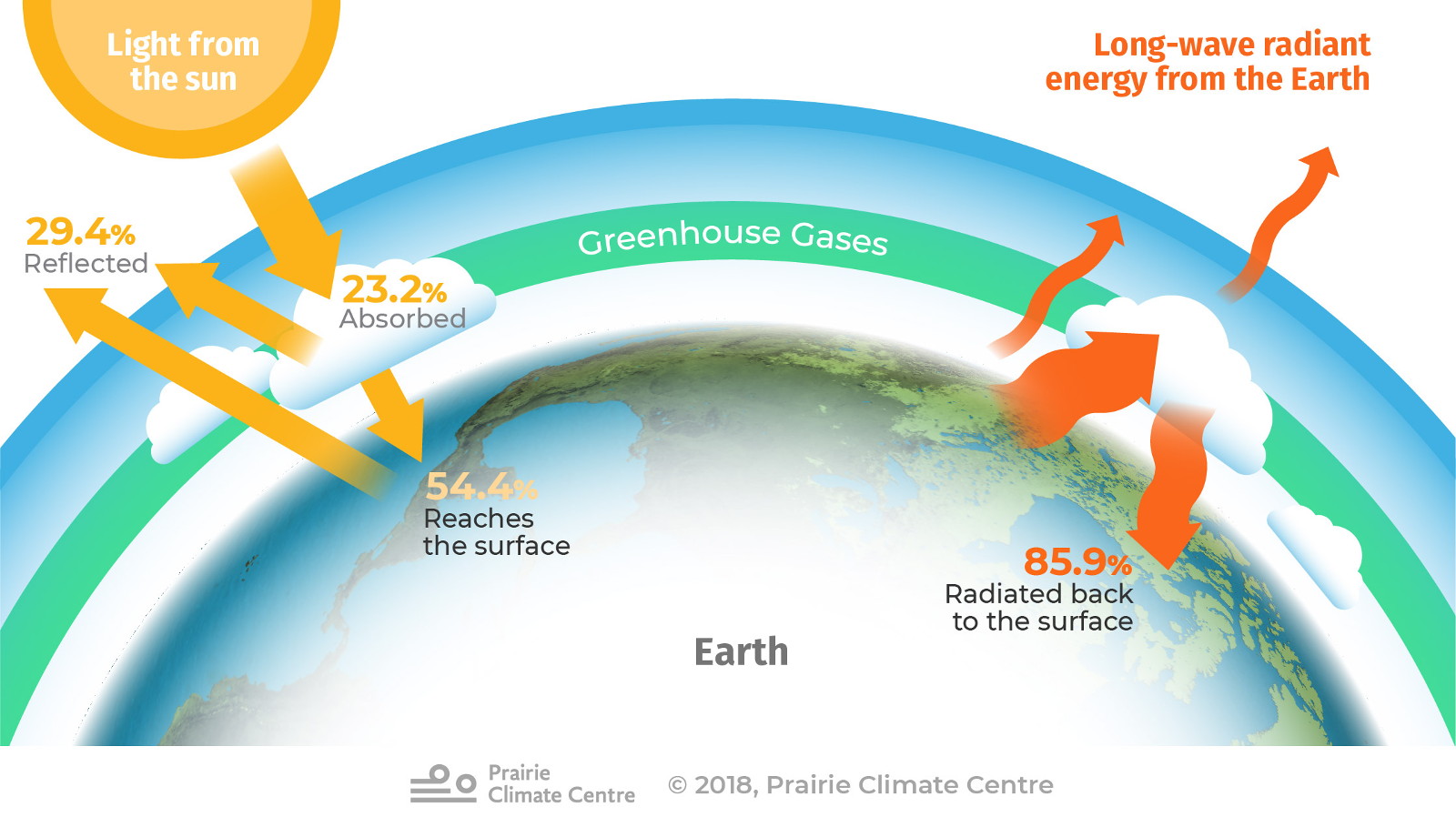
Figure 5: A diagram explaining the work of greenhouse gases [28].
- Carbon dioxide, or CO2, is emitted whenever something burns. It is the most prevalent GHG, making up over 55% of all long-term GHGs according to some measurements. The US Environmental Protection Agency uses it as a marker because of its widespread use. Carbon dioxide's global warming potential, or GWP, is 1 [29].
Table 1: A table displaying the top 10 CO2 emitting countries in the world in 2022. [30]
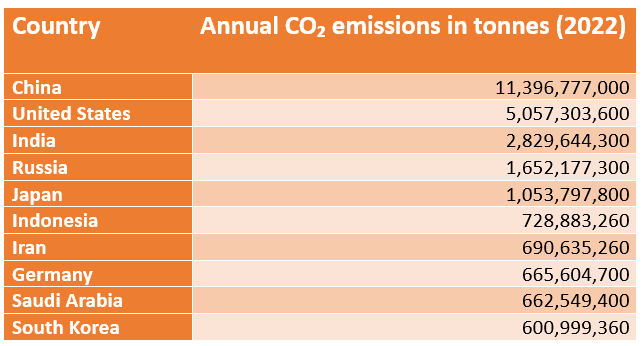
- Methane, or CH4, is created by various combustion processes as well as anaerobic decomposition, which occurs, for instance, in flooded rice fields, cow and pig stomachs, and ponds holding pig excrement. Although methane decomposes after around ten years, it is a precursor to ozone, another significant greenhouse gas. The GWP of CH4 is 28–36 [29].
- Nitrous oxide in laughing gas, also known as NO/N2O or simply NOx, is a waste product from the manufacturing and application of fertilizers as well as from other industrial activities and the burning of specific materials. Although nitrous oxide has a very long atmospheric half-life, its GWP is 265-298 when compared to CO2 at 100 years [29].
- Although intended to replace ozone-depleting refrigerants, fluorinated gases have become incredibly persistent, significantly warming greenhouse gases. They are wholly artificial and have no natural origins. Their GWPs range from 1,800 to 8,000 at the 100-year point of comparison, with some varieties exceeding 10,000 [29].
- Sulfur hexafluoride, sometimes known as SF6, is primarily utilized in dielectric materials, particularly dielectric liquids, for specialized medical treatments. In high-voltage applications like transformers and grid switching gear, they are employed as insulators. With a GWP of 22,800, SF6 has a long half-life in the high atmosphere, lasting thousands of years [29].
However, it is important to note that according to scientific research, carbon dioxide is essential for preserving the stability of Earth's atmosphere. Removing carbon dioxide would result in the collapse of the terrestrial greenhouse effect and a significant decrease in Earth's surface temperature, roughly 33°C (59°F) [27].
There are greenhouse gases in the atmosphere of Earth. Because of its ideal climate—neither too hot nor too cold—Earth is sometimes called the "Goldilocks" planet. This is because life may flourish there. The natural greenhouse effect that keeps Earth's average temperature at 15 °C (59 °F) contributes to why the planet is so hospitable. But over the past century, human activity has upset Earth's energy balance, primarily through burning fossil fuels, which has sent greenhouse gases like carbon dioxide into the atmosphere. The atmosphere and seas now contain more carbon dioxide due to this. The amount of carbon dioxide in the atmosphere has been steadily increasing for decades, trapping additional heat close to the surface of the Earth and raising temperatures [27].
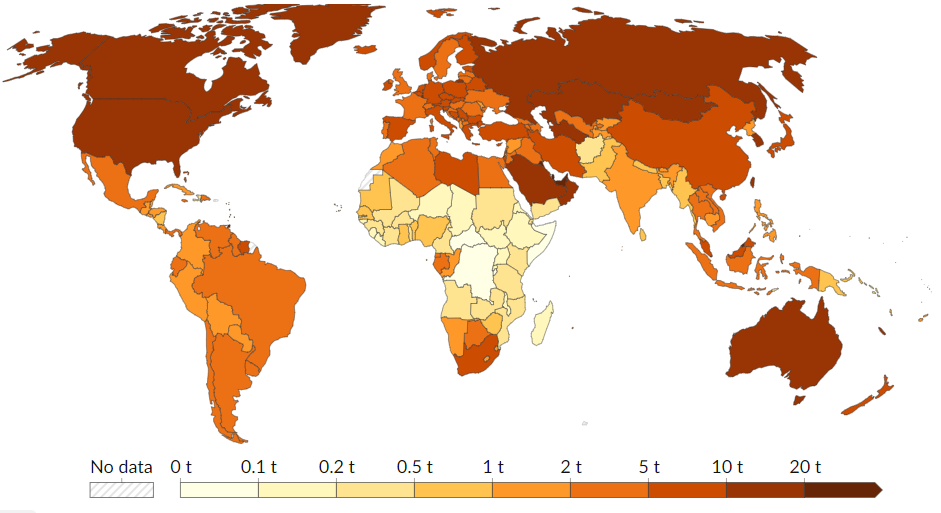
Figure 6: A world map displaying CO2 emissions per capita in 2022. Globally, there are significant disparities in emissions per person. The main oil-producing nations are the ones that release the most CO2 emissions globally per person; this is especially true for those with small populations. The majority are in the Middle East and include Kuwait, Bahrain, Qatar, and the United Arab Emirates. Nonetheless, a large number of the leading oil producers have tiny populations, which results in low annual emissions overall. The United States, Australia, and Canada are more populous countries with some of the greatest per capita emissions, and consequently high overall emissions; on average, their emissions are around three times greater than the global average. The world's per capita CO2 emissions are still extremely low in many nations. The average annual footprint in many of the poorest Sub-Saharan African nations, including Chad, Niger, and the Central African Republic, is approximately 0.1 tonnes. Comparing that to the USA, Australia, and Canada, it is about 150 times lower. In less than two days, the ordinary Australian or American generates the same amount of emissions as the average individual in Mali or Niger does in a full year [30].

Figure 7: A visual display of CO2 emitting countries in the world, with Asia as the dominant continent and China dominating as a country at 31%, which is nearly 1/3 of the total world emissions [31].
WHAT EVIDENCE DO WE HAVE OF CLIMATE CHANGE?
Long-term data relating atmospheric CO2 levels and global temperature, sea level, the extent of ice, the fossil record, and species distribution are the most persuasive pieces of evidence scientists have about climate change.
This data, which spans millions of years, demonstrates a robust relationship between temperature and CO2 concentrations. According to recent research, a trend of rising CO2 levels and temperatures started in the early 19th century.
Due to the interconnectedness of all components of the global climate, scientists have developed models that illustrate how changes brought about by global warming should manifest throughout the system and in other domains, such as sea level, mild weather, and fish species migration in the ocean [29].
Visual Impacts of Climate Change Evidence [29]
| Melting Glaciers | Rising Sea Levels |
|
|
 |
| Flooding | Worsening Droughts |
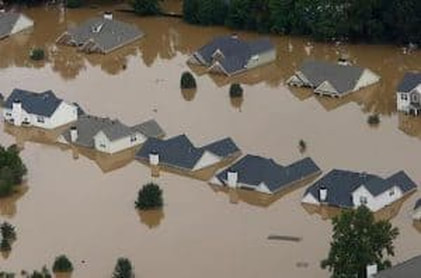 |
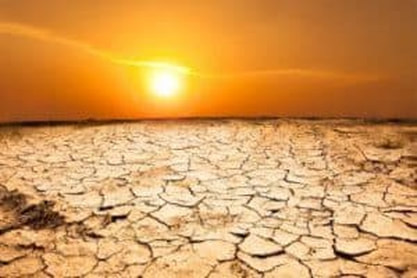 |
| Supercell Storms | Increasing Tornados |
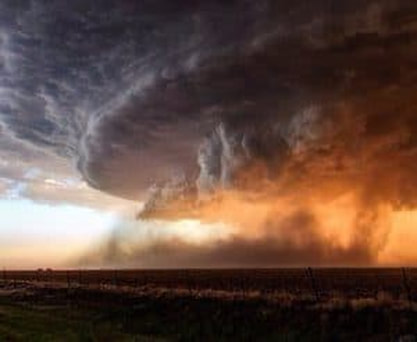 |
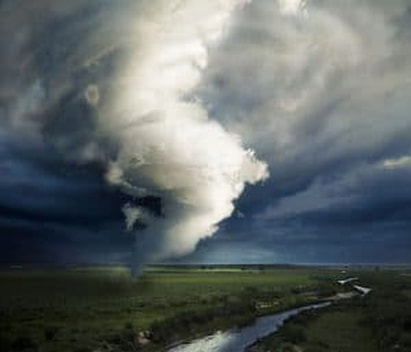 |
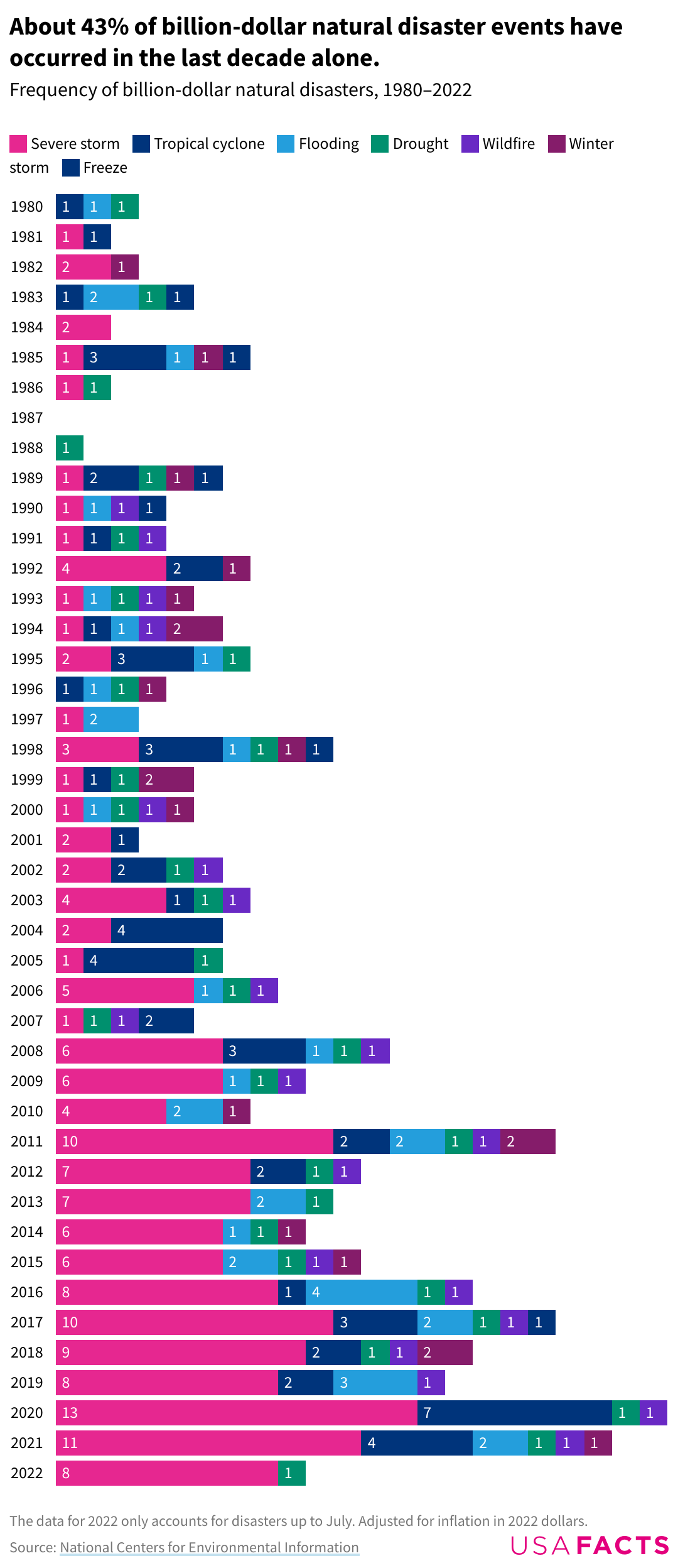
Figure 8: Billion-dollar natural disasters that occurred in the United States since 1980. In the 1980s, there were a total of 31 billion-dollar natural disaster events, resulting in 2,970 deaths. In the 2010s, this number rose to 128 such events, resulting in 5,227 deaths. [32]
Do all scientists agree that climate change is occurring and is caused by human activity?
Scientists worldwide agree that global warming is happening and that human activity causes it [33].
The IPCC Fifth Assessment Report (AR5), written by a panel of hundreds of climate experts and scientists from member countries of the World Meteorological Organization, the United Nations Environmental Programme, plus a team of external reviewers, states unambiguously [33]:
Human influence on the climate system is clear, and recent anthropogenic emissions of green-house gases are the highest in history. […] Warming of the climate system is unequivocal, and since the 1950s, many of the observed changes are unprecedented over decades to millennia.
IPCC Fifth Assessment Report (AR5)
WHAT IS COP 28?
The United Nations Climate Change Conference, or COP 28, was held in Dubai, United Arab Emirates, from November 30, 2023, to December 12, 2023.
Annual UN Climate Change Conferences, often known as COPs, are the world's sole global climate change decision-making platform, with nearly all nations participating.
In short, the purpose of the COP is to reach a global consensus on solutions to the climate catastrophe, like keeping the increase in global temperature to 1.5 degrees Celsius, assisting communities most vulnerable to the consequences of climate change, and reaching net-zero emissions by 2050.
The UN Framework Convention on Climate Change (UNFCCC) member states (or Parties) were among the more than 70,000 delegates at COP 28. Participants included journalists, young people, Indigenous Peoples, climate scientists, business executives, and a variety of other professionals and stakeholders.
The 28th Conference of the Parties (COP) to the UNFCCC is officially known as COP 28 [34].
Why is COP 28 important?
The main details of the Paris Agreement on climate change have been negotiated and agreed in recent years, so COP 28 aims to implement the agreement and increase ambition and action.
The latest research from the UN Intergovernmental Panel on Climate Change shows that greenhouse gas emissions need to be reduced by 43 percent by 2030 compared to 2019 levels. This is crucial to limiting the temperature rise to 1.5 degrees Celsius by the end of this century and avoid the worst effects of climate change, including more frequent and severe droughts, heat waves and precipitation.
COP 28 is an opportunity to find global solutions to limit the global temperature increase to 1.5 degrees, inform countries about the preparations for revised and more ambitious national climate plans for 2025, accelerate the already ongoing green transition and finally reach the goals of the Paris Agreement [34].
Critical outcomes agreed at the COP 28 climate talks 2023
The COP 28 Presidency overview of the key outcomes of global climate action spread across the four pillars in 2023, fast-tracking a just, orderly, and equitable energy transition, fixing climate finance, focusing on people, lives and livelihoods, and underpinning everything with full inclusivity [35].
Fast-tracking a just, orderly, and equitable energy transition
Decarbonizing the electricity system quickly is essential to maintaining the 1.5 °C target. In order to achieve this, the demand and supply sides of the clean energy transition must move more quickly. However, this transition must be fair, just, and orderly, and it must also take energy security into consideration. The Global Renewables and Energy Efficiency Pledge was introduced by the COP 28 Presidency, who played a significant role in hastening the energy transition. The Pledge, which has the support of 130 national governments (including the European Union (EU) as of December 11), mandates that signatories cooperate to triple the installed capacity of renewable energy worldwide to at least 11,000 GW by 2030 and to collectively double the average annual rate of energy efficiency improvements from approximately two percent to over four percent globally until 2030. In addition, the Presidency oversaw the beginning of programs aimed at sectoral emission reduction through cooperation with both Parties and non-Party stakeholders. Sixty-six country governments have signed the Global Cooling Pledge for COP 28, pledging to collaborate in order to cut cooling-related emissions worldwide by at least 68% by 2050 compared to 2022 levels across all sectors. With regard to low-carbon hydrogen and hydrogen derivatives, the 37 national government participants in the Mutual Recognition of Certification Schemes for Renewable and Low-Carbon Hydrogen and Hydrogen Derivatives shall endeavor to achieve mutual recognition of their individual certification programs. The 52 parties that have signed the Oil and Gas Decarbonization Charter pledge to achieve near-zero upstream methane emissions by 2030, net-zero operations by 2050 at the latest, and a stop to routine flaring by then. With the support of 35 businesses, the Industrial Transition Accelerator will accelerate the decarbonization of heavy-emitting industries like transportation, industry, and energy [35].
Fixing climate finance
The significance of tackling developing nations' debt and altering the global financial system has also been recognized at COP 27, even if a significant mobilization of public and private capital is still imperative. Numerous national governments and organizations made climate finance commitments during COP 28, focusing on the Green Climate Fund, Adaptation Fund, Least Developed Countries Fund, and Special Climate Change Fund, among others. Thirteen country governments signed the UAE Leaders' Declaration on a Global Climate Finance Framework, which was spearheaded by the COP 28 Presidency. The Framework aims to provide access to climate finance for all through collaborative efforts, large-scale delivery, and opportunity for all. Additionally, a report will be submitted in relation to the implementation of this framework right after COP 28 [35].
Focusing on people, lives and livelihoods
Record-breaking temperatures and climate-related disasters highlight the increasing need for all stakeholders to take more effort to adapt and strengthen resilience, particularly in areas that are already at risk. With stakeholders from various systems, the Sharm el-Sheikh Adaptation Agenda (SAA), which was introduced and welcomed by Parties at COP 27, has accelerated this effort all year long. Over 30 global adaptation outcome targets are presented in this crucial agenda, which is urgently needed by 2030 to boost the resilience of four billion people. In 2023, a steering committee and thematic task forces related to the impact systems were formed. In order to eliminate adaptation gaps and increase resilience between now and 2030, the first implementation report presented at COP28 examines the achievements to date as well as the obstacles still to be overcome. The SAA has focused on issues related to health, food and agriculture, and nature, and throughout COP 28, the High-Level Champions have demonstrated progress on the Agenda. It is significant that the report emphasizes the introduction of four new Adaptation Outcomes on health, centered around finance, surveillance systems, heat resilience, and health infrastructure and facilities, among its many other findings and messages. Regarding food and agriculture, it also highlights how plans might be integrated with other sectoral or local investments and plans to expedite their execution. Furthermore, it highlights the advancements in standards and guidelines pertaining to nature, including the universal definition and acceptance of the phrase "nature-based solutions" as well as more sophisticated guidelines for private organizations for target-setting and nature-related risk disclosure. According to the report, an increasing number of banks, investors, and insurers are realizing the dangers of doing nothing and the new opportunities that come with resilience and adaptation [35].
Underpinning everything with full inclusivity
Communities and society are impacted by climate change, vulnerable communities and marginalized groups most notably. As a result, a crucial component of the process conducted in accordance with UN principles is guaranteeing the representation of all voices globally. In this context, the UNFCCC Executive Secretary and the COP 28 Presidency jointly published a statement prior to COP 28 pledging to collaborate in order to make COP 28 the most inclusive UN Climate Change Conference to date. The nomination of the Youth Climate Champion is another early move taken by the COP 28 Presidency. The COP27 Youth Envoy served as the model for the position, which was established by the Presidency. The Dubai Youth Dialogue was organized by the COP 28 Presidency, the Youth Climate Champion, and YOUNGO, the official UNFCCC children and youth constituency. Additionally, YOUNGO, with the backing of the Youth Climate Champion, unveiled the results of the Youth Stocktake, a procedure that was started at the 58th Subsidiary Bodies Sessions to gather data on the advancement of youth inclusion and policy implementation. An essential component of inclusion is gender equity. Leading the charge in establishing the COP 28 Gender-Responsive Just Transitions and Climate Action Partnership were the COP 28 Presidency and the COP 28 HighLevel Champion. In addition to reuniting for dialogue at COP 32 to report on the implementation of the Partnership's commitments, the 78 national governments that signed the Partnership pledge to work cooperatively to support fair and inclusive transitions that advance gender equality and the objectives of the enhanced Lima Work Program on Gender and its Gender Action Plan [35].
CURRENT AND PROPOSED STRATEGIES FOR CLIMATE CHANGE
| Strategies | Effectiveness | Challenges |
| Policy Interventions [36] | Policies play a crucial role in addressing climate change. International agreements, such as the Paris Agreement, aim to limit global temperature increases. However, effectiveness depends on the commitment and implementation by individual countries. Some nations have made significant strides, while others lag. | The challenge lies in enforcement, as well as achieving consensus among diverse nations with varying economic and political interests. |
| Technological Innovations [37] | Technological advancements, such as renewable energy sources, carbon capture and storage, and sustainable agriculture practices, can contribute significantly to mitigation efforts. The growth of electric vehicles and improvements in energy efficiency are positive signs. | The pace of technological adoption and implementation is often slower than needed. Additionally, affordability and accessibility can be barriers, especially for developing nations. |
| Community-Based Initiatives [38] | Local initiatives, including community-led conservation projects, sustainable farming practices, and resilient infrastructure development, can positively impact. Engaging communities fosters a sense of ownership and responsibility. | These initiatives often require sufficient resources, education, and collaboration. Some communities may lack the capacity to implement effective measures without external support. |
In summary, the effectiveness of adaptation and mitigation strategies depends on a combination of factors, including political will, international cooperation, technological innovation, community engagement, and financial resources. A holistic and integrated approach that combines policy interventions, technological innovations, and community-based initiatives is crucial for addressing the complex and interconnected challenges posed by climate change. Ongoing evaluation, adjustment, and global collaboration are essential for the success of these strategies.
CANADA'S PLAN TO COMBAT CLIMATE CHANGE

Figure 9: 2022 was the 16th hottest year since 1948 in Canada, with an average temperature that was 1.2 degrees Celsius (°C) higher than the reference figure for 1961 to 1990. The annual average temperature deviations from 1948 to 2022 show a tendency of 1.9°C warming during that time. From 1997 onward, the annual average temperature was continuously higher than or equal to the reference figure [39].
FEDERAL GOVERNMENT
Milestone to Achieve by 2030: Reduction of Emissions
The Government of Canada has taken bold and immediate action to reduce greenhouse gas emissions and fight climate change while also promoting sustainable jobs and clean industrial growth. The 2030 Emissions Reduction Plan is a sector-by-sector roadmap that outlines how Canada will achieve its emissions reduction target of 40% below 2005 levels by 2030 and net-zero emissions by 2050. The Plan has been developed with inputs from over 30,000 Canadians, provinces and territories, Indigenous Peoples, industry, and the independent Net-Zero Advisory Body. The Plan is an ambitious and achievable one, and it reflects the collective efforts of millions of Canadians [40].

Figure 10: Predicted Canadian GHG emissions when using and not using Canada's Climate Plans [40].
Milestone to Achieve by 2050: Net-Zero Emissions
The transition to a cleaner, more affluent economy must be both an immediate priority and a sustained commitment over the coming years and decades. To achieve this long-term aim, Canada must continue to innovate, reinforce, and expand on existing policies. That is why Canada is committed to attaining net-zero emissions by 2050, and why the government passed the Canadian Net-Zero Emissions Accountability Act to offer an accountability and transparent framework for meeting this goal [40].
What is Net-Zero?
Achieving net-zero emissions implies that the economy should either emit no greenhouse gas emissions or offset its emissions through actions like tree planting or using technologies that capture carbon before its release into the air. It is crucial to keep the world livable and safe for future generations. Over 120 countries, including all G7 nations (Germany, France, Italy, Japan, the United Kingdom, and the United States), have committed to being net-zero emissions by 2050. Several provinces and cities, such as Toronto, Hamilton, Vancouver, Halifax, Guelph, Newfoundland and Labrador, and recently Quebec, have already pledged to be net-zero by 2050. Nova Scotia and British Columbia have implemented or plan to implement provincial net-zero-by-2050 legislation. Additionally, Prince Edward Island has committed to achieving net-zero greenhouse gas emissions by 2040 [40].
Canada’s Plan to Reach Net-Zero
The Net-Zero Emissions Accountability Act was implemented in Canada on June 29, 2021, with a focus on achieving net-zero emissions by 2050. The Act aims to ensure that the government remains transparent and accountable in its efforts to meet the targets. As per the Act, public participation and independent advice are required to guide the Government of Canada's initiatives [40].
Net-Zero Advisory Body
In February 2021, the Net-Zero Advisory Body (NZAB) was launched, consisting of up to 15 members who possess relevant experience and knowledge. The Advisory Body offers independent advice to the Minister of Environment and Climate Change, supporting Canada's net-zero target.
Following this, in November 2021, the Minister of Environment and Climate Change and the Minister of Natural Resources requested advice from the Net-Zero Advisory Body. The advice pertains to guiding principles that will inform the development of quantitative five-year targets for caps on emissions from the oil and gas sector. This advice will aid the Government in capping and reducing emissions from the sector at a pace and scale that will help achieve net zero by 2050 [40].
Net-Zero Accelerator Fund
As a component of the plan for Canada, the $8 billion Net-Zero Accelerator Fund has been initiated by the Government of Canada, which will assist significant emitters in decreasing their emissions. Algoma Steel Inc. is one such beneficiary that will get up to $420 million from the Fund to modernize its operations and discontinue coal-fired steelmaking procedures at its Sault Ste. Marie, Ontario plant. This will result in 500 job opportunities and a reduction in emissions by 3 million tonnes annually by 2030 [40].
The Net-Zero Challenge
Canadian companies have a crucial responsibility to assist the country in achieving net-zero emissions. To transition their facilities and operations to net-zero emissions by 2050, businesses are encouraged to create and execute reliable and effective plans through the Net-Zero Challenge. The Net-Zero Challenge is open to any Canadian company or business [40].
PROVINCIAL (ALBERTA) GOVERNMENT
The strategy of Alberta aims to achieve the status of a carbon-neutral economy by 2050 without compromising the affordability, reliability, and security of energy for Albertans, Canadians, and the rest of the world.
To achieve this, Alberta will utilize the existing infrastructure, skills, innovation, and ability to promote emissions reductions outside the boundaries at a pace that ensures safety, dependability, and affordability for Albertans and Canadians.
To make this happen, collaboration with businesses is necessary to develop practical ways to minimize emissions in all sectors while exploring new technologies that might not be scalable or practicable at present.
The primary goal is to attract investment by creating a predictable, nimble, and certain regulatory and investment environment. Building relationships with Indigenous Peoples will play a crucial role in reconciliation, and Indigenous leadership in natural resource and energy development is essential [41].
Vision, strategic directions and principles
Alberta's vision is to achieve global leadership in the areas of emissions reductions, innovation and technology, and sustainable development of resources. The foundation of Alberta's approach consists of the strategic directions and principles [41]:
- An Alberta plan based on practical, achievable pathways
- Delivering Alberta energy to the world while reducing emissions
- Affordability and reliability
- Energy security
- Partnership with Indigenous communities and organizations
- Industrial policy and systems approach
- Sustainable finance
- Conservation, protection and enhancement of nature-based solutions
Emissions reductions across all sectors
The Emissions Reduction and Energy Development Plan provides the following strategies for reducing emissions across many sectors of Alberta's economy.
Indigenous leadership
Indigenous engagement and participation have been critical to prior success in lowering emissions, and they will be critical in the future to delivering on the Emissions Reduction and Energy Development Plan. To enable economic gains to flow to communities, the path to lowering emissions and developing energy must include an open and trusting collaboration with Indigenous partners [41].
Industrial carbon pricing
Alberta's third-generation industrial carbon pricing and emissions trading system is the Technology Innovation and Emissions Reduction (TIER) regulatory system. In 2007, Alberta became the first jurisdiction in North America to impose a carbon price on industrial emissions, and Alberta's leadership in industrial carbon pricing has been recognized nationally and globally as a practical and innovative way to reduce emissions while launching new projects and creating jobs [41].
Emission offsets
Alberta's plan encourages reductions in all sectors by utilizing carbon offsets earned by projects that have voluntarily lowered their greenhouse gas emissions [41].
Clean technology
Alberta Innovates, Emissions Reduction Alberta, the Alberta Enterprise Corporation, academics, business, and other entities are collaborating to create and market clean technologies. The parties involved are working together to break down barriers and advance technology through all stages of development, from early-stage research to turnkey-ready solutions [41].
Carbon capture, utilization and storage (CCUS)
Alberta is ideally suited to CCUS. We have a well-established regulatory procedure and are one of the few countries with the geology to store enough CO2 to achieve carbon neutrality by 2050. In Alberta, a broad and expanding number of CCUS projects have been submitted, and 25 CCUS hubs for review have been awarded in 2022. These hubs could help oil sands decarbonization programs as well as power, clean hydrogen, petrochemicals, upgrading and refining, cement, steel, fertilizer, biodiesel manufacturing, and gas processing. These billion-dollar projects will position Alberta to cut emissions locally while also allowing Alberta products to compete strongly in a worldwide market [41].
Emissions reductions by sector
Alberta's leadership will maintain significant commitments in all sectors of the economy.
Oil and gas - conventional, oil sands and bitumen beyond combustion
Alberta's oil sands comprise 95% of Canada's oil reserves, and in 2021, the province will produce 62% of Canada's natural gas and 85% of its oil and equivalent. A crucial aspect of this strategy involves maintaining sustainable resource generation in Alberta while also reducing the province's carbon footprint [41].
Electricity
The economic and energy future of Alberta necessitates a diverse electricity grid that can withstand high demand periods. To achieve this, a strategic approach towards decarbonizing the electricity sector in Alberta should be followed. This approach should prioritize reliability and affordability, while also maximizing the use of current infrastructure, reducing the risk of stranded assets, encouraging technology development and deployment, and creating high-quality employment opportunities [41].
Geothermal
Geothermal is a clean, renewable energy source that has the potential to assist Alberta in meeting its need for power and heat, including, but not limited to, improving energy and community resiliency for Indigenous and rural communities [41].
Hydrogen
Alberta's resources allow for large-scale production of low-cost, low-carbon-intensity hydrogen, commonly known as clean hydrogen, which is extremely competitive in the rapidly expanding worldwide hydrogen market. Alberta is already the top producer of hydrogen in Canada [41].
Critical minerals
Worldwide demand for key minerals is increasing as a result of population increase, advancements in technology, and the worldwide transition to a lower-carbon economy. Alberta's enormous resources, infrastructure, and competence in responsible resource development position the province as a global supplier of choice to promote energy security [41].
Circular economy and waste
Circular economy solutions can help to reduce the environmental, economic, and social implications of material creation, processing, and disposal while also enabling economic diversification into lower-emissions products [41].
Bioenergy, transportation and buildings
Bioenergy can be utilized as a blending agent to reduce greenhouse gas emissions from standard fuel combustion. This provides a possible avenue to reducing emissions without significantly altering existing infrastructure, customer behavior, or in-place devices [41].
Agriculture
Alberta farmers and ranchers are long-standing land stewards who are constantly working to reduce their carbon and environmental footprints while increasing productivity and resilience to climate change to support global food security [41].
Forestry
Alberta's strong regulatory structure is founded on world-class principles of sustainable forest management. Natural carbon sequestration, cultural and traditional values, watershed functions, biodiversity, recreational activities, and a vital fiber supply for industry are all supported by a healthy, well-managed forest [41].
Heavy industry
Many Alberta operations in the sector are emissions-intensive and trade-exposed, which means they face higher compliance costs to reduce emissions and may be less able to manage those costs due to global market price setting [41].
Land and nature-based solutions
Both natural and managed landscapes possess the ability to store substantial amounts of carbon, which can effectively reduce the levels of greenhouse gases present in our atmosphere. Furthermore, this can help safeguard our natural systems and landscapes while also increasing their resilience in the face of a changing climate [41].
Other actions and opportunities
The plan identifies a number of other actions, opportunities and initiatives to support environmental outcomes, reduce emissions and grow the Albertan economy:
- Consider forming a sustainable finance advisory committee to make recommendations on Canadian taxonomy and the investment framework required to guarantee the proper checks and balances are in place and to foster innovation in Alberta.
- Collaborate with companies, industry associations, and the postsecondary community to ensure that the skills being produced are marketable.
- Continue to collaborate with partners such as environmental non-governmental organizations, industry, Indigenous organizations, municipalities, labor groups, and others to develop effective policies and programs to support the Emissions Reduction and Energy Development Plan's implementation.
- Create a youth advisory group to provide viewpoints on environmental issues.
- Create evidence-based policies and initiatives, including a grasp of the environmental, social, and economic consequences of policy choices.
- Publish reports that detail the progress and outcomes of the Emissions Reduction and Energy Development Plan initiatives [41].
CALGARY MUNICIPALITY
Climate Emergency Declaration
Calgary City Council voted on November 15, 2021, to declare a Climate Emergency. A climate emergency declaration is a resolution passed by a governing body, such as a municipal council. It commits the local government to taking emergency action in response to climate change and recognizes the urgency and scale of action required.
Climate Emergency Declarations have been issued by over 2,000 jurisdictions and local governments worldwide, representing over one billion inhabitants, including most major cities in Canada and the Government of Canada.
Declaring a Climate Emergency in Calgary means:
- Calgary declares a state of emergency due to climate change.
- That the City of Calgary will join the global community (not-for-profit, public, and private sectors) in combating climate change through international initiatives such as the Global Covenant of Mayors, Resilient Cities Network, and Race to Zero, by implementing best practices and leveraging capital investment with the goal of becoming a global center of excellence in climate adaptation and mitigation, as well as energy transformation.
- That the City of Calgary prioritizes climate change by shortening the timelines for climate action to reduce greenhouse gas emissions and updating the city-wide and corporate greenhouse gas reduction targets to achieve net zero emissions by 2050 in order to help limit global warming to 1.5 degrees Celsius.
- That the City of Calgary, through the Indigenous Relations Office, engage with First Nations to establish relationships, assure collaboration, incorporation of traditional knowledge, and intersectional Climate Change initiatives.
- That the City of Calgary prioritizes climate change by shortening the timelines for reducing greenhouse gas emissions and amending the city-wide and corporate greenhouse gas reduction targets to achieve net zero emissions by 2050.
- That the City of Calgary develop strategic business strategies and budgets across all departments to identify, invest in, and accelerate initiatives like high priority emissions reduction, climate risk reduction possibilities, and carbon budget implementation.
- This Council directs the City of Calgary to revise agreements with civic partners and subsidiaries in order to assist and assure alignment with Calgary's emissions reduction targets.
- That the City of Calgary will advocate for funding from all levels of government to accelerate immediate and near-term actions to reduce greenhouse gas emissions, reduce climate risk to public built and natural infrastructure, provide upstream flood and drought mitigation on the Bow River, build community resilience, reduce disaster risk from climate change, and support strategic opportunities for Calgary's economy [42].
How does Calgary contribute to climate change?
In Calgary, buildings' power demands for heating and lighting, along with transportation emissions, are responsible for around two-thirds and one-third of the total greenhouse gas emissions, respectively. Methane from landfills is the cause of the remaining one per cent of emissions. The City of Calgary's operations, including buildings, facilities, fleet, and landfills, contribute only four per cent of the total emissions, while the remaining 96 per cent is the responsibility of Calgary's residential, commercial, industrial, and institutional sectors [42].
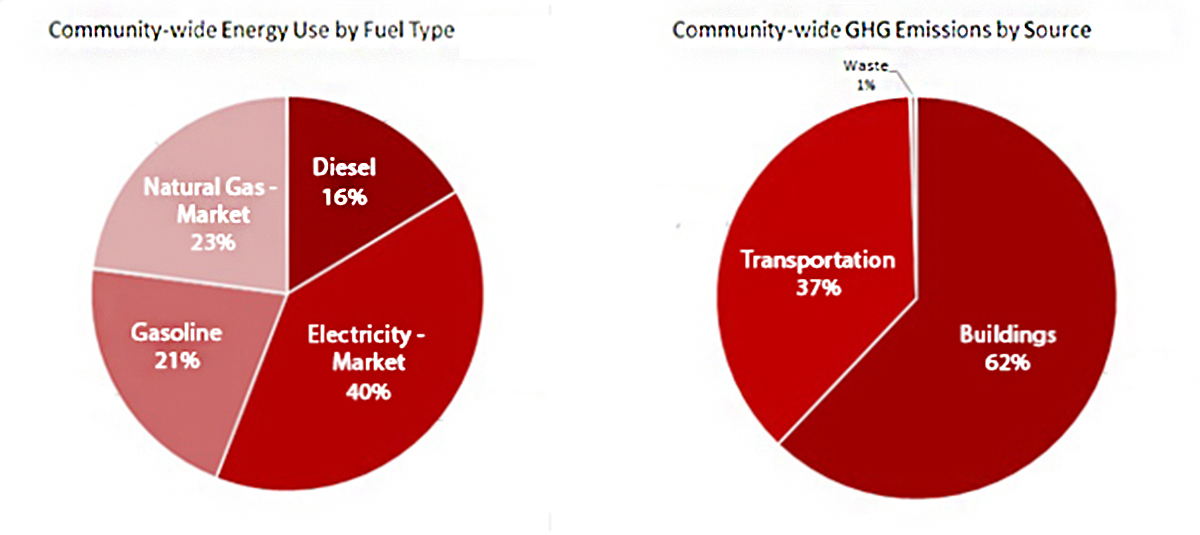
Figure 11: Two different pie graphs. The one on the left expresses the community-wide amount of energy consumption for different fuel types. The one on the right displays the community-wide GHG emissions for three different sources [42].
What does climate change mean for Calgary?
Alberta's c limate has shifted significantly in recent decades. Alberta's average yearly temperature is anticipated to rise further.
According to climate models, Calgary will see more severe and frequent extreme weather events like heat waves, droughts, and severe storms.
Climate change dangers endanger the health and welfare of Calgary residents, the economy, public infrastructure and services, residences and private property, and natural ecosystems.
Climate change increases the likelihood and severity of eight climatic disasters [42]:
 |
Extreme heat:Calgary's summers will become increasingly hot, with more frequent and prolonged heat waves. |
|
Heavy rainfall:More precipitation is falling as short-duration, high-intensity storms (SDHIs), which can cause overland flooding. |
 |
Drought:Drought conditions may become more common, persistent, and extensive. |
|
Heavy snowfall:As long as the core winter months remain below 0°C, damaging winter storms, heavy snow, and blizzard conditions will persist. |
 |
Wildfire:A longer and drier fire season will result in more frequent, massive, and intense wildfires. |
|
Severe storms:Hail, severe wind events, and tornadoes are anticipated to occur more frequently and over longer periods of the year. |
 |
Shifting seasons:Winters are shortening, spring is arriving earlier, summers are longer, and fall is arriving later. |
|
River flooding:Flood timing, intensity, and frequency are anticipated to increase. |
Data
I did not collect any data through surveys for this comprehensive research project. Any data from websites is included throughout my project.
Conclusion
The scientific evidence presented in this research overwhelmingly supports the reality of climate change, dispelling any myths or misconceptions. The Earth is undeniably experiencing a warming trend primarily caused by human activities, such as the burning of fossil fuels and deforestation. The consequences are evident in rising global temperatures, sea levels, and the increasing frequency of severe weather events.
Raising awareness about climate change is not merely an academic pursuit; it is an urgent call for action. Through awareness, individuals can motivate themselves, instigate change in behavior, and contribute to the collective effort needed to address this critical issue. Climate literacy is crucial, especially among the younger generation, as it empowers them to make informed decisions, alter attitudes, and adapt to the challenges posed by global warming.
This research project serves as a beacon, aiming to deepen our understanding of climate change's various facets, from environmental impacts to human-induced factors. Its objectives extend beyond scientific inquiry; it seeks to contribute to a global movement that addresses climate change comprehensively. By fostering collaboration between scientists, policymakers, and communities, the project aims to drive interdisciplinary approaches, advocate for sustainable practices, and provide valuable insights to the global climate knowledge base.
Such sustainable practices that can be done to fight climate change include:
- Save energy at home
- Change your home's source of energy
- Walk, bike or take public transport
- Switch to an electric vehicle
- Consider your travel (airplanes)
- Reduce, reuse, repair and recycle
- Eat more vegetables
- Throw away less food
- Plant native species
- Clean up your environment
- Make your money count
- Protecting our forests
- Speak up [43]
As we move forward, it is imperative that we not only acknowledge the reality of climate change but also actively engage in mitigating its effects. Through collective efforts, we can forge a more sustainable future for ourselves and generations to come. The time to act is now, and this research project stands as a testament to our commitment to understanding, addressing, and combatting this global issue to save the planet and generations to come.
Citations
[1] US EPA, O. (2021, April 14). Frequently Asked Questions About Climate Change. Www.epa.gov. https://www.epa.gov/climatechange-science/frequently-asked-questions-about-climate-change#:~:text=The%20earth%20does%20go%20through
[2] Khan, A. (2022, March 17). Why is raising awareness on climate change important? SfS. https://www.sustainabilityforstudents.com/post/why-is-raising-awareness-on-climate-change-important
[3] Turrentine, J. (2022, December 13). What Are the Solutions to Climate Change? NRDC. https://www.nrdc.org/stories/what-are-solutions-climate-change#fossil-fuels
[4] Beliefs about global warming vary by country. (2015, August 27). https://www.snexplores.org/article/beliefs-about-global-warming-vary-country
[5] COP28 UAE | What is COP. (n.d.). Www.cop28.com. https://www.cop28.com/en/what-is-cop
[6] United Nations. (2023). What Is Climate change? Climate Action; United Nations. https://www.un.org/en/climatechange/what-is-climate-change
[7] National Geographic. (2022). Climate Change | National Geographic Society. Education.nationalgeographic.org; National Geographic Society. https://education.nationalgeographic.org/resource/climate-change/
[8] Cho, R. (2019, June 20). How Climate Change Impacts the Economy. State of the Planet. https://news.climate.columbia.edu/2019/06/20/climate-change-economy-impacts/#:~:text=Warmer%20temperatures%2C%20sea%20level%20rise
[9] Fossil fuels and climate change: the facts. (2022, February 18). Www.clientearth.org. https://www.clientearth.org/latest/news/fossil-fuels-and-climate-change-the-facts/#:~:text=When%20fossil%20fuels%20are%20burned
[10] Bertrand, S. (2021, December 17). Fact Sheet | Climate, Environmental, and Health Impacts of Fossil Fuels (2021) | White Papers | EESI. Environmental and Energy Study Institute. https://www.eesi.org/papers/view/fact-sheet-climate-environmental-and-health-impacts-of-fossil-fuels-2021
[11] United Nations. (n.d.). Causes and Effects of Climate Change. United Nations. https://www.un.org/en/climatechange/science/causes-effects-climate-change#:~:text=As%20greenhouse%20gas%20emissions%20blanket
[12] National Geographic Society. (2023, October 19). Deforestation. Education.nationalgeographic.org; National Geographic. https://education.nationalgeographic.org/resource/deforestation/
[13] WWF. (2022). The Effects of Deforestation. WWF; WWF. https://www.wwf.org.uk/learn/effects-of/deforestation#:~:text=Trees%20absorb%20and%20store%20carbon
[14] Greenpeace. (n.d.). Solutions to Deforestation. Greenpeace USA. https://www.greenpeace.org/usa/forests/solutions-to-deforestation/#:~:text=By%20consuming%20less%2C%20avoiding%20single
[15] Causes of Climate Change. (2021, April 15). Www.epa.gov. https://www.epa.gov/climatechange-science/causes-climate-change#:~:text=Greenhouse%20Gases
[16] Laboratory, S. U. H. I. on E. C. A. A. F.-P. S. B. A. B. Nasa. J. P. (2019, October 2). The Atmosphere: Earth’s Security Blanket. Climate Change: Vital Signs of the Planet. https://climate.nasa.gov/news/2914/the-atmosphere-earths-security-blanket/#:~:text=Not%20only%20does%20it%20contain
[17] Lindsey, R., & Dahlman, L. (2024, January 18). Climate Change: Global Temperature. Climate.gov; NOAA. https://www.climate.gov/news-features/understanding-climate/climate-change-global-temperature
[18] Lindwall, C. (2022, October 24). What Are the Effects of Climate Change? NRDC; NRDC.org. https://www.nrdc.org/stories/what-are-effects-climate-change#weather
[19] Lindsey, R. (2021, January 25). Climate Change: Global Sea Level | NOAA Climate.gov. Www.climate.gov. https://www.climate.gov/news-features/understanding-climate/climate-change-global-sea-level#:~:text=Global%20warming%20is%20causing%20global
[20] sarah. (2015, May 5). In too deep? Climate change and rising sea level. Curious. https://www.science.org.au/curious/earth-environment/too-deep-climate-change-and-rising-sea-level
[21] US EPA, O. (2016, June 27). Climate Change Indicators: U.S. and Global Precipitation. US EPA. https://www.epa.gov/climate-indicators/climate-change-indicators-us-and-global-precipitation#:~:text=As%20average%20temperatures%20at%20the
[22] US EPA, O. (2016, June 27). Climate Change Indicators: Ocean Acidity. Www.epa.gov. https://www.epa.gov/climate-indicators/climate-change-indicators-ocean-acidity#:~:text=Carbon%20dioxide%20reacts%20with%20sea
[23] United Nations. (2022). Biodiversity - our strongest natural defense against climate change. United Nations; United Nations. https://www.un.org/en/climatechange/science/climate-issues/biodiversity
[24] US EPA, O. (2016, December 22). Climate Impacts on Ecosystems. 19january2017snapshot.epa.gov. https://19january2017snapshot.epa.gov/climate-impacts/climate-impacts-ecosystems_.html#:~:text=Climate%20change%20can%20alter%20where
[25] Species Distribution and Climate Change | Climate Change Resource Center. (n.d.). Www.fs.usda.gov. https://www.fs.usda.gov/ccrc/topics/species-distribution-and-climate-change#:~:text=The%20changing%20climate%20is%20affecting
[26] EPA. (2014). Future of Climate Change | Climate Change Science | US EPA. Climatechange.chicago.gov. https://climatechange.chicago.gov/climate-change-science/future-climate-change#:~:text=Future%20changes%20are%20expected%20to
[27] NASA. (2023, November 8). FAQ: What is the greenhouse effect? Climate Change: Vital Signs of the Planet. https://climate.nasa.gov/faq/19/what-is-the-greenhouse-effect/#:~:text=Greenhouse%20gases%20consist%20of%20carbon
[28] Greenhouse Gases | Climate Atlas of Canada. (n.d.). Climateatlas.ca. https://climateatlas.ca/greenhouse-gases#:~:text=Earth
[29] What is Climate Change? A Definition of Climate Change. (n.d.). Warm Heart Worldwide. https://www.warmheartworldwide.org/what-is-climate-change.html?gad_source=1&gclid=CjwKCAiAyp-sBhBSEiwAWWzTnjOfYCo-LqRHbmXQBHGR1huB0X3neEtTyM_jORJunIdu-_eHgp50qBoC230QAvD_BwE
[30] Ritchie, H., & Roser, M. (2020). CO2 emissions. Our World in Data. https://ourworldindata.org/co2-emissions
[31] Lu, M. (2023, November 9). Visualizing all the world’s carbon emissions by country. Visual Capitalist. https://www.visualcapitalist.com/carbon-emissions-by-country-2022/
[32] USA Facts. (2022, October 10). Is the number of major natural disasters increasing? USAFacts. https://usafacts.org/articles/are-the-number-of-major-natural-disasters-increasing/
[33] Union of Concerned Scientists. (2017). Scientists Agree: Global Warming is Happening and Humans are the Primary Cause. Union of Concerned Scientists. https://www.ucsusa.org/resources/global-warming-happening-and-humans-are-primary-cause
[34] UNFCCC. (2023). About COP 28. Unfccc.int. https://unfccc.int/process-and-meetings/conferences/un-climate-change-conference-united-arab-emirates-nov/dec-2023/about-cop-28
[35] Summary of Global Climate Action at COP 28. (n.d.). https://unfccc.int/sites/default/files/resource/Summary_GCA_COP28.pdf
[36] United Nations. (2023). The Paris Agreement. United Nations Climate Change; United Nations. https://unfccc.int/process-and-meetings/the-paris-agreement
[37] unfccc. (2016). Technology and the UNFCCC Building the Foundation for Sustainable Development. https://unfccc.int/ttclear/misc_/StaticFiles/gnwoerk_static/NAD_EBG/54b3b39e25b84f96aeada52180215ade/b8ce50e79b574690886602169f4f479b.pdf
[38] Transformation Starts Locally Communities Leading Sustainable Construction. (n.d.). Utilities One. Retrieved February 6, 2024, from https://utilitiesone.com/transformation-starts-locally-communities-leading-sustainable-construction
[39] Canada, E. and C. C. (2016, April 28). Temperature change in Canada. Aem. https://www.canada.ca/en/environment-climate-change/services/environmental-indicators/temperature-change.html
[40] Government Of Canada. (2020, June 23). What’s in Canada’s climate plan. Aem. https://www.canada.ca/en/services/environment/weather/climatechange/climate-plan/climate-plan-overview.html
[41] Emissions Reduction and Energy Development Plan | Alberta.ca. (n.d.). Www.alberta.ca. https://www.alberta.ca/emissions-reduction-and-energy-development-plan#:~:text=projects%20and%20employment.-
[42] Management, E. & S. (n.d.). Calgary’s Climate Program. Https://Www.calgary.ca. https://www.calgary.ca/environment/climate/climate-change.html?redirect=/climateprogram
[43] United Nations. (2020). Actions for a Healthy Planet. United Nations; United Nations. https://www.un.org/en/actnow/ten-actions
Acknowledgement
I want to give a grateful thank you to my school science fair coordinator, Ms. Heather Lai, as well as to both my parents for their support.
I would also like to give an appreciated wave to all those whose expertise I have cited.
Thank you all for enabling me to submit my project to such a fantastic event!


